Dell UltraSharp U2711: Quality has a Price
by Jarred Walton on January 22, 2010 2:00 AM EST- Posted in
- Displays
Dell U2711 Color Quality
We'll start with a look at the color quality of the U2711, broken down into two areas: Color gamut and color accuracy (i.e. Delta E). We'll start by explaining the former. Color gamut refers to the ability for a display to represent all of the colors in a defined selection of colors. In this case, we use the Adobe RGB standard to define the base gamut, and we measure the percentage of that standard that a display is able to cover - higher being better.
Delta E is the difference between a requested color and the color that actually appears on the display, with lower being better - i.e. the displayed color doesn't have a large delta relative to what was requested. If a display has perfect color accuracy, Delta E will be 0.0; in practice, anything less than 1.0 is nearly perfect and no one will notice the difference. A Delta E of 2.0 or less is the desired result after calibration, meaning no one color measures higher than 2.0 on our standard 24 color palette. Such a result would be fit for use in any professional imaging environment. Finally, while Delta E of around 4.0 is visible to the naked eye, it's really a question of reference points; if you don't have something better nearby and you're not going to print or view content on other media, a result where all colors measure 4.0 or less is very good.
So how does the U2711 do in these areas? First let's look at the charts, and then we'll discuss what they mean. We used the Graphics and Adobe RGB setting on the U2711, with brightness set at 36% (~200nits) and contrast at the default 50%.
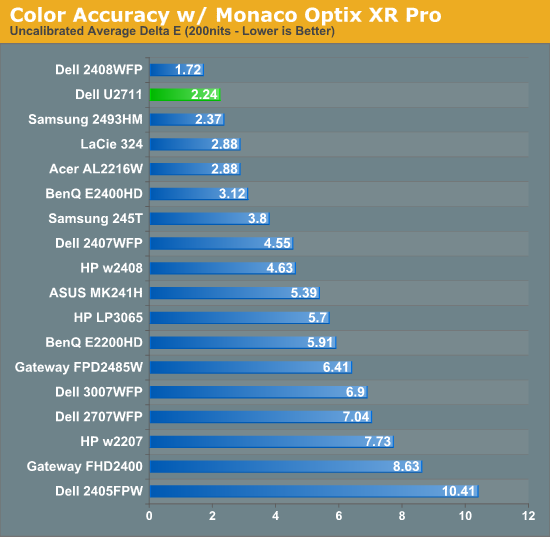
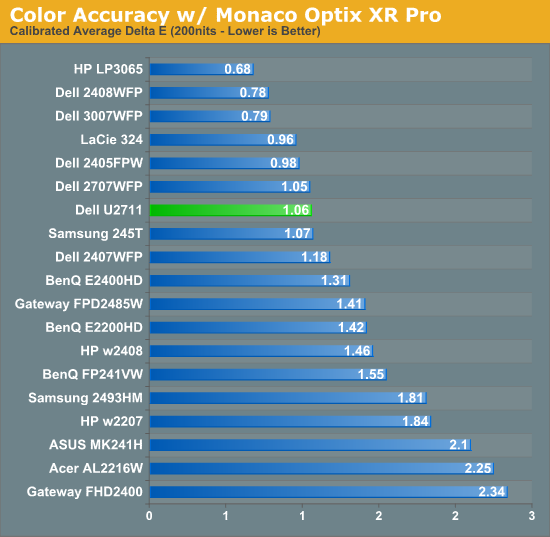
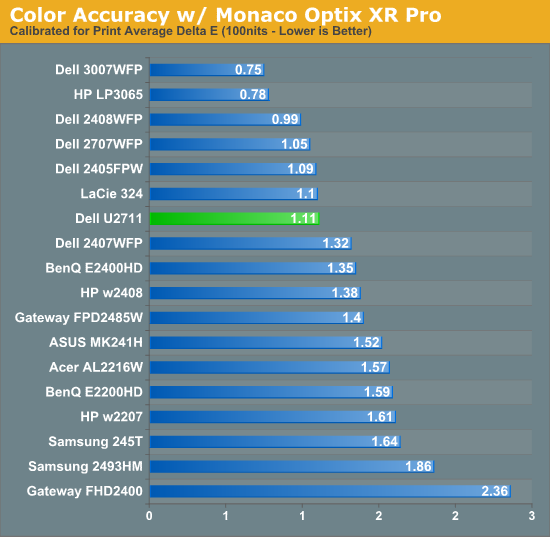
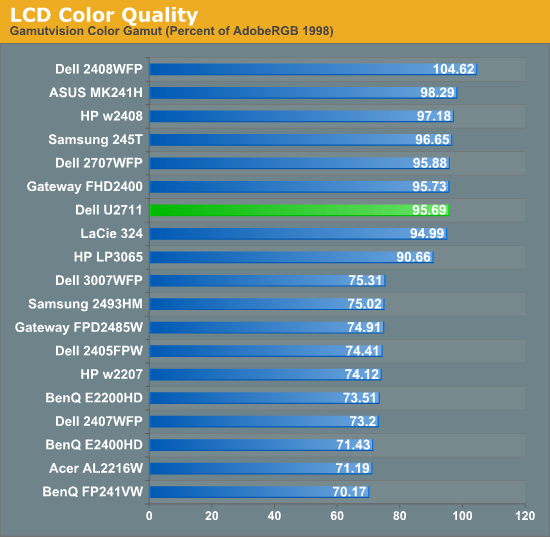
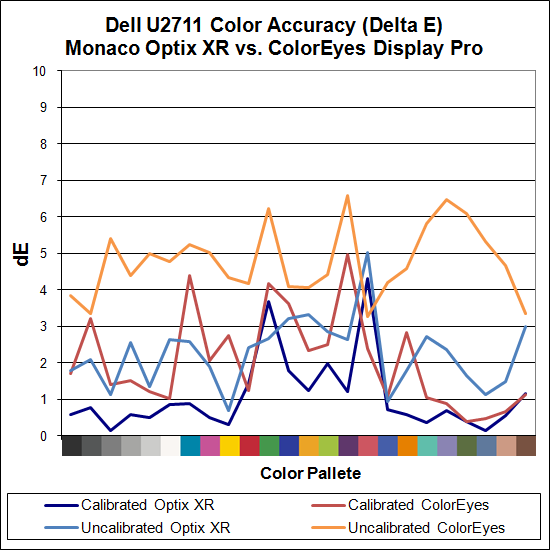
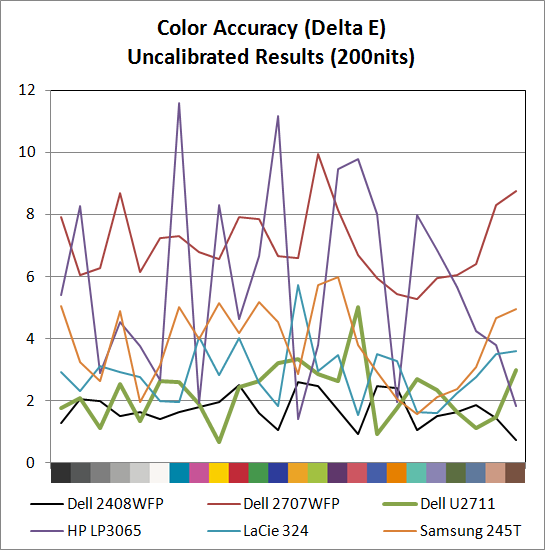
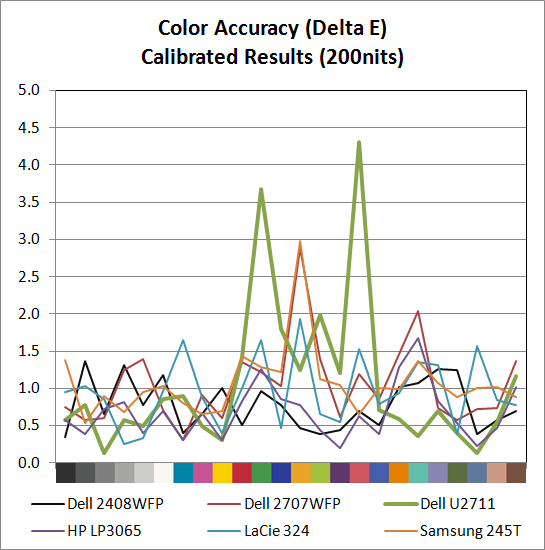
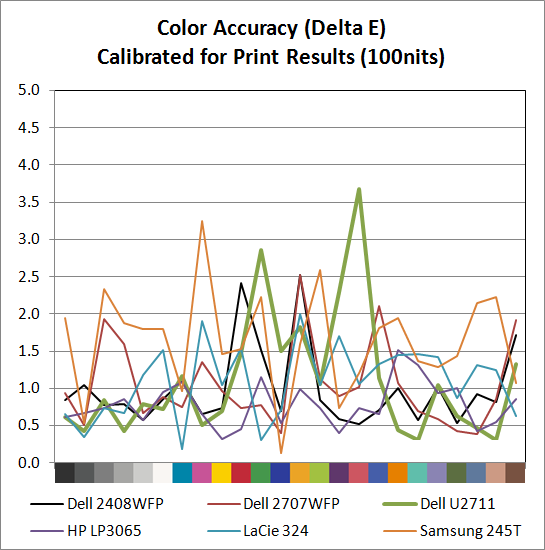
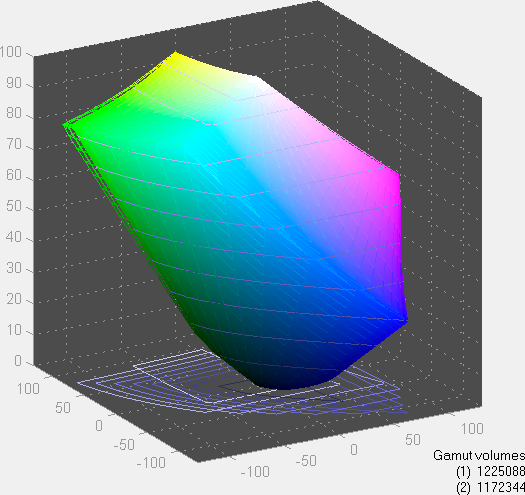
The U2711 scores extremely well in color gamut, and it achieves the 96% of Adobe RGB that Dell claims in their literature (not that most users would really notice the difference between any of the displays rated 90% to 105% - at least not after you eliminate the TN panels). Color accuracy on the other hand is a bit of a mixed bag. Dell ships a paper with test results showing the color calibration of each individual U2711, with the claim that the displays will have an average Delta E of less than 5.0 without any end-user calibration (when using the sRGB and Adobe RGB settings). Dell uses Minolta Color Analyzer CA210 and 32 test colors while we test with ColorEyes Display Pro and Monaco Optix XR Pro and 24 test colors, but our Monaco results confirm their claim. We're not sure why, but we continue to get better results using Optix XR Pro than with ColorEyes Display Pro.
As far as Optix is concerned, the U2711 achieves the rated Delta E of < 5.0 at just 2.24 without calibration, which is an excellent result. In fact the U2711 has no colors in the standard Gretag Macbeth 24 color palette score higher than 5.0 (and only reddish-pink scores a 5.0 measurement). The only LCD we've tested that did better is Dell's own 2408WFP (which also, interestingly enough, had an Adobe RGB color gamut of 105%). ColorEyes also gives an average Delta E of less than 5.0, but at 4.78 the score isn't nearly as remarkable, with nine color measurements well above 5.0. The uncalibrated (Monaco) results put the U2711 ahead of the HP LP3065, Dell 2707WFP, Samsung 245T, and LaCie 324 - and just about every other LCD we've tested.
Switch to the calibrated results and the U2711 doesn't impress quite as much relative to the competition. Monaco gives the U2711 an average Delta E of 1.06, which is great, but there are two results above 3.0 (the worst is reddish-pink again, this time at 4.31) compared to displays like the HP LP3065 where the highest measured Delta E is just 1.68. Dell's own 2707WFP, a three-year-old offering, also delivered a similar average Delta E but with only two colors above 2.0 (and still under 3.0). For a better LCD (i.e. not a TN panel), the results are really only slightly above average. It is possible different calibration software would achieve a better end result, but really we're talking about a "problem" that only the most demanding users are likely to ever notice.
Color Consistency
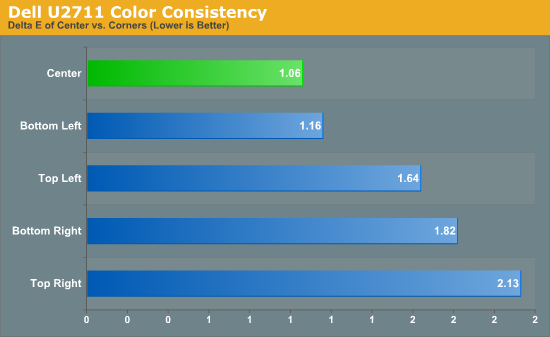
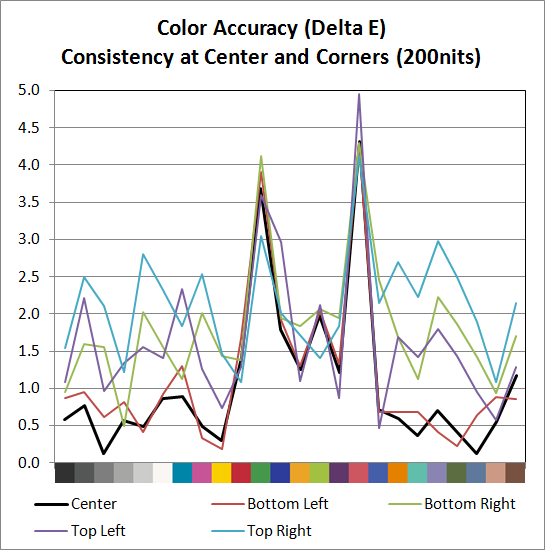
We added another test to try and measure the panel consistency across the entire surface. We measure Delta E at the center of the display, but what happens on the edges? To test this, we used the same profile generated in our best Delta E test result and measured Delta E again at the four corners. Most of the scores are similar, with a slight increase in average Delta E relative to the center measurement. The bottom-left corner is nearly identical to the center measurement, the top-left and bottom-right are a bit worse, and the top-right corner gets the overall worst result. While on the one hand we could say that the Delta E on the top-right is twice that of the center measurement, it's not a case of being "twice as bad". In fact, the color consistency is very good, and we didn't notice any "hot spots" are areas where the colors were clearly off relative to the rest of the LCD.










153 Comments
View All Comments
ninjackn - Friday, January 22, 2010 - link
The color gamut issues stems from issues with applications not using ICC profiles. It was a huge problem in windows XP because so few applications cared to use color profiles. It's gotten a lot better with windows vista/7 (or with OSX) but it still pops up from time to time, specifically with all those images on the web missing color information.Here's a website that shows what i'm talking about:
http://www.gballard.net/psd/go_live_page_profile/e...">http://www.gballard.net/psd/go_live_page_profile/e...
JarredWalton - Friday, January 22, 2010 - link
Okay, I read through that, tried it on Firefox 3.5.7, IE8, and Safari 4. I get the problem now... it's not having a wide color gamut LCD, but rather viewing images that have an ICC profile in applications that don't respect those profiles, right?In terms of internet publishing, I'd have to agree that we need to standardize, and since sRGB is already the standard there's no point in going elsewhere. For an imaging professional where the content isn't going on the web, though, wouldn't you want the better color space? I always "save for web" if I'm going to post an image online, and that strips out any ICC profile information (AFAIK).
I need to go play with this on the U2711 with and without a monitor profile (and using sRGB and Adobe RGB) to see what effect - if any - it has on the experience. Stay tuned....
CSMR - Friday, January 22, 2010 - link
Save for web should give an sRGB label and does with Photoshop CS3. No point in stipping it out.FF is color managed. As soon as IE becomes color-managed it will be fine to use any color spaces in web images. Microsoft has been fairly good about color management of late, so hopefully in IE9, fingers crossed.
velis - Friday, January 22, 2010 - link
To me, this monitor is more interesting from a different viewpoint:It's one of the rare few monitors that offer 2560 resolution at less than 30" size. And even this one only has 109 DPI resolution.
If this monitor was 22 - 24" in size, I'd buy it without second thought.
Of course you need to run Word at 150% magnification, but the fonts look just awesome with so many pixels available to render them. Not to mention games. A "fairly powerful" graphics card is needed though.
The only problem is that current display managers, be it Windows or Linux are all still raster ones and can't really adapt well to increased DPI displays.
Perhaps if more monitors like this would show up on the market, MS and Linux gurus would finally develop true vector user interfaces. Then we could have 150, 200 and even more DPI displays. I'm wondering how many more years before displays catch up to what printers had some 20 years ago already.
CSMR - Friday, January 22, 2010 - link
High dpi is very useable, even with normal pixel pitches 120dpi can be a good option. But yes vector graphics would make the benefit of higher dpi displays even greater.There is vector support in WPF since Vista so Windows is getting there at least.
Plus modern applications (including OS) tend to have raster graphics at various dpis, I think often including 150, so that is improving even without vector graphics.
But the fact is most people don't need very high dpi so we have to wait for the cost to come down. Also for displayport to become common once dvi reaches its limit and that will take a while.
dasgib - Friday, January 22, 2010 - link
I'm really curious about to know if the matte displays of the U2711 has the known "anti-glare effect" which many people complain about on 24" IPS monitors (like the HP LP2475w and Dell U2410)?I don't like glossy displays (as most people do), but I had to send the stated HP display back because of that anti-glare effect.
MadMan007 - Friday, January 22, 2010 - link
I have the HP and it's not bad as far as anti-glare coating although not the best I've seen - that would be a Samsung but sadly it was TN. It helps to sit a reasonable distance away, like a mere 2 feet or more. Every single Dell I've seen is far worse in terms of grainy anti-glare which is a shame because it means I can't consider Dell monitors at all, it just drives me too crazy to see whites all sandy-sparkly-grainy. It really makes me wonder how more Dell users don't even notice it at all.Maybe they've gotten better though? I'd sure like to know.
dasgib - Friday, January 22, 2010 - link
I just asked Jarred about this via email. Hopefully we get an answer soon :)JarredWalton - Friday, January 22, 2010 - link
I haven't noticed any negative effects from the anti-glare coating. I use a Dell 3007WFP normally and haven't ever noticed a problem there either. Mostly, I see the "grainy effect" on cheap TN panels, but maybe I'm just one of those people that isn't bothered by what you're referring to. Anyway, FWIW I feel the U2711 has the same appearance as the 3007WFP and I enjoy the picture. I don't notice "more graininess" or anything like that.MadMan007 - Friday, January 22, 2010 - link
There may be some confusion here over the word 'graininess.' It is not a screen-door effect, pixel pitch by-product or defect in the actual image. It is the screen coating itself - it's not 'grainy' per se in the way a film might be grainy, it's 'sparkly' is my best word for it. Another way to describe it is if you took some sand and lightly dusted the screen surface with it - the image itself looks fine but there's always this layer above it that has its own effect on the image. It makes things 'sparkly' -tiny random dots of coloration across the specturm. For some people it may blend together, I don't know, but I can't see how it's possible to miss entirely. Dell's anti-glare is known to be heavby and particularly prone to this effect which is why it's brought up. Check out forum threads about Dell monitors and you'll find plenty of people noting it.Now someone who uses a Dell monitor all the time may get used to it especially if they never have another monitor next to it. But Jarred you surely have seen a variety of screens. Have you ever set them up side-by-side with your Dell? What about a laptop screen if you have one? Or if you have access to a glossy screen at least to compare, they by nature will not have any anti-glare coating problem.